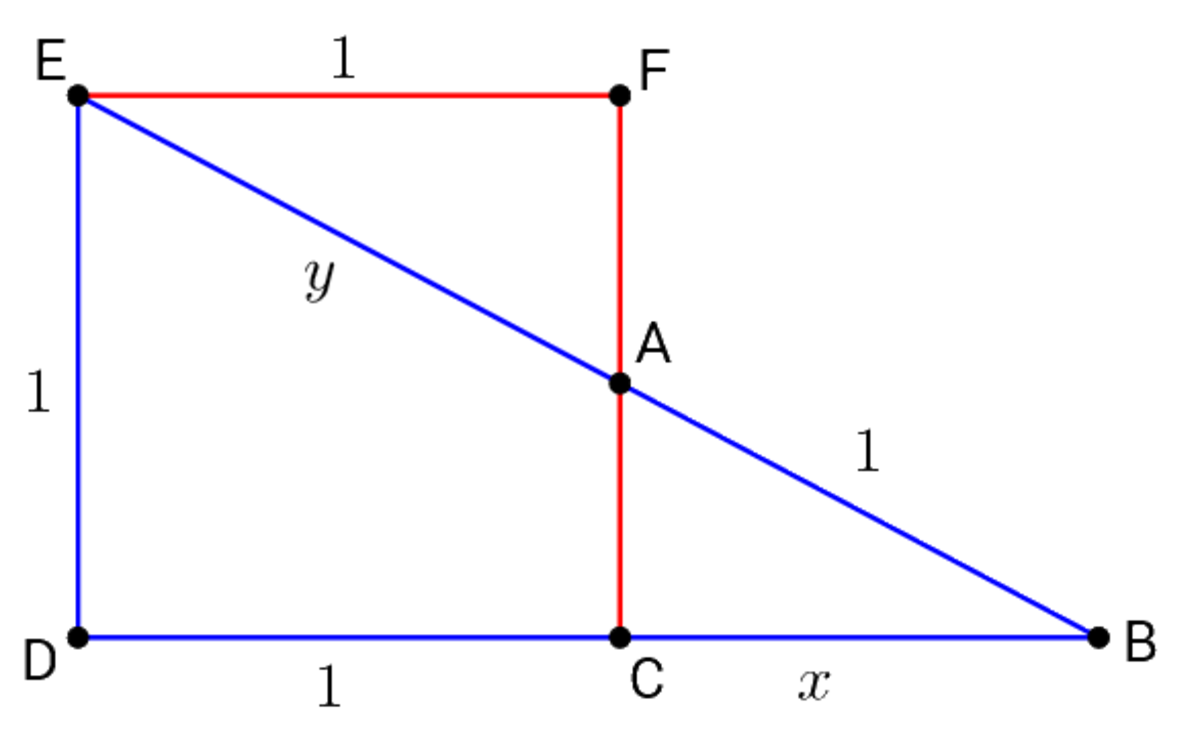Trigonometry or Square completing?
In the diagram above, the blue right triangle is partially overlapping the 1 × 1 red square, sharing a corner. If A B = 1 and B C = x , find x to 3 decimal places.
The answer is 0.883.
This section requires Javascript.
You are seeing this because something didn't load right. We suggest you, (a) try
refreshing the page, (b) enabling javascript if it is disabled on your browser and,
finally, (c)
loading the
non-javascript version of this page
. We're sorry about the hassle.
3 solutions
We can write x 4 + 2 x 3 + x 2 − 2 x − 1 ( x 2 + x + 1 ) 2 x 2 + x + 1 x 2 + ( 1 ∓ 2 ) x + ( 1 ∓ 2 ) ( x + 2 1 ( 1 ∓ 2 ) ) 2 = 0 = 2 ( x + 1 ) 2 = ± 2 ( x + 1 ) = 0 = 4 1 ( 1 ∓ 2 ) 2 − ( 1 ∓ 2 ) = 4 1 ( 1 ∓ 2 ) ( − 3 ∓ 2 ) For a real root x , we must choose the sign to make the RHS positive. Thus ( x + 2 1 ( 1 − 2 ) ) 2 x + 2 1 ( 1 − 2 ) = 4 1 ( 2 − 1 ) ( 3 + 2 ) = 4 1 ( 2 2 − 1 ) = ± 2 1 2 2 − 1 and we now pick the positive root.
A monic quartic can always be written in the form ( x 2 + a x + b ) 2 + c ( x + d ) 2 for some constants a , b , c , d . Thus a quartic equation can be solved by first taking square roots, and then solving a pair of quadratics. In general you have to be able to solve a cubic equation to determine these four constants, but in this case it was easy.
You can plot any equation using this tool. https://www.desmos.com/calculator
Log in to reply
You also can plot any equation using this tool "Wolfram" (search in Google Play)
I tried by taking x= cosδ and converted it into a quadratic in terms of trigonometric terms but I am getting 0.468.I don't know what is wrong with my method.

It can be seen that Triangle BED ~ Triangle BAC
S o , B C / B D = A C / E D
x/(x+1) = [ √ ( A B ) 2 − ( B C ) 2 ] / 1
x = ( x + 1 ) ( √ 1 − x 2 )
Squaring both sides
x 2 = ( x + 1 ) 2 ( 1 − x 2 )
x 2 = ( x 2 + 2 x + 1 ) ( 1 − x 2 )
x 2 = x 2 + 2 x + 1 − x 4 − 2 x 3 − x 2
x 2 = 2 x + 1 − x 4 − 2 x 3
0 = 2 x + 1 − x 4 − 2 x 3 − x 2
Solve this Quartic for x. The only root positive root to above equation is
x = 0 . 8 8 3
Since △ A B C △ A E F it follows that A F = C F = 2 1 which makes the triangles 30-60-90 triangles and so x = 2 1 3
△ A B C and △ A E F are similar, not congruent. Your method is good for getting an estimate, since they are so close to being congruent. Note that the exact value is a little bit off:
Estimate: Actual: 2 1 3 2 1 ( − 1 + 2 + 2 2 − 1 ) ≈ 0 . 8 6 6 . ≈ 0 . 8 8 3 .
Log in to reply
It did take my answer as correct. But if I look at the picture again my reasoning should lead to a contradiction... So my answer is o deed faulty
Define the remaining points in the figure as below:
It can be seen that △ A B C ∼ △ A E F . Then y = x 1 . Apply the Pythagorean Theorem on △ E B D :
( x + 1 ) 2 + 1 2 x 2 + 2 x + 2 x 4 + 2 x 3 + x 2 − 2 x − 1 = ( 1 + x 1 ) 2 = 1 + x 2 + x 2 1 = 0
Edit : See @Mark Hennings comment for how to solve this quartic. The only positive root to the equation above is:
x = 2 1 ( − 1 + 2 + 2 2 − 1 ) ≈ 0 . 8 8 3 .